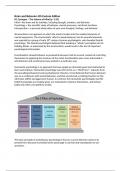Brain and Behavior 4th Custom Edition
H1 Cacioppo – The Science of Mind (p. 3-32)
Mind = the brain and its activities, including thought, emotion, and behavior.
Psychology = the scientific study of behavior, mental processes, and brain functions.
Introspection = a personal observation of your own thoughts, feelings, and behavior.
Structuralism is an approach in which the mind is broken into the smallest elements of
mental experience. The structuralists’ effort to break behavior into its essential elements
was rejected by a group of early 20th-century German psychologists, who founded Gestalt
psychology. The Gestalt psychologists believed that breaking a “whole” perception into its
building blocks, as advocated by the structuralists, would result in the loss of important
psychological information.
Functionalism viewed behavior as purposeful because it led to survival. Instead of restricting
themselves to exploring the structure of the mind, functionalists were more interested in
why behavior and mental processes worked in a particular way.
Humanistic psychology is an approach that saw people as inherently good and motivated to
learn and improve. Humanistic psychology was referred to as a “third force”, separate from
the prevailing behaviorist and psychodynamic theories. Freud believed that human behavior
was on a continuum with animal behavior, and that society had a civilizing function on the
otherwise selfish and aggressive human. In contrast, the humanistic psychologists had the
belief that people are innately good, are motivated to improve themselves, and behave
badly only when corrupted by society.
The basic principle of evolutionary psychology is that our current behavior exists in its
present form because it provided some advantage in survival and reproduction to our
ancestors.
, H1 Kalat – The Cellular Foundations of Behavior
Module 1.1 – The Biological Approach to Behavior (p. 34-45)
Perception occurs in your brain. When something contacts your hands, the hand sends a
message to your brain. You feel it in your brain, not your hand. Furthermore, what you
perceive is not what something actually is.
Mental activity and certain types of brain activity are, so far as we can tell, inseparable. This
position is known as monism, the idea that the universe consists of only one type of being.
People differ from one another in countless ways, and many of the differences can be traced
to differences in the brain.
Biological explanations of behavior fall into four categories:
- Physiological explanation – relates a behavior to the activity of the brain and other
organs.
- Ontogenetic explanation – describes how something develops.
- Evolutionary explanation – reconstructs the evolutionary history of a structure or
behavior.
- Functional explanation – describes why a structure or behavior evolved as it did.
Given that most biological psychologists and neuroscientists are primarily interested in the
human brain and human behavior, why do they study nonhumans?
- Many of the mechanisms of behavior are similar across species, and sometimes they
are easier to study in a nonhuman species.
- We are interested in animals for their own sake, humans are naturally curious.
- What we learn about animals shed light on human evolution.
- Legal or ethical restrictions prevent certain kinds of research on humans.
Module 1.2 - Neurons and Other Cells (p. 46-56)
The surface of a cell is its membrane, a structure that separates the inside of the cell from
the outside environment. Most chemicals cannot cross the membrane, but protein channels
in the membrane permit a controlled flow of water, oxygen, sodium, potassium, calcium,
chloride, and other important chemicals.
The cell body, or soma, contains the nucleus, ribosomes, and mitochondria.
Mitochondriën zijn de batterijtjes of de energiefabriekjes van de cel en komen voor in elke
cel van het lichaam, behalve in de rode bloedcellen. Mitochondria produceren bijna alle
energie die we in ons lichaam nodig hebben om te leven en te groeien. Als ze falen, is er een
tekort aan energie in de cel.
A motor neuron, with its soma in the spinal cord, receives excitation through its dendrites
and conducts impulses along its axon to a muscle. A sensory neuron is specialized at one end
to be highly sensitive to a particular type of stimulation
Many vertebrate axons are covered with an insulating material called a myelin sheath with
interruptions known as nodes of Ranvier. Invertebrate axons do not have myelin sheath.





